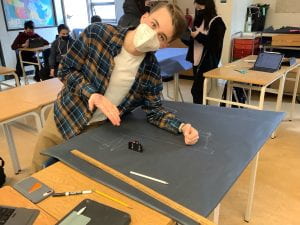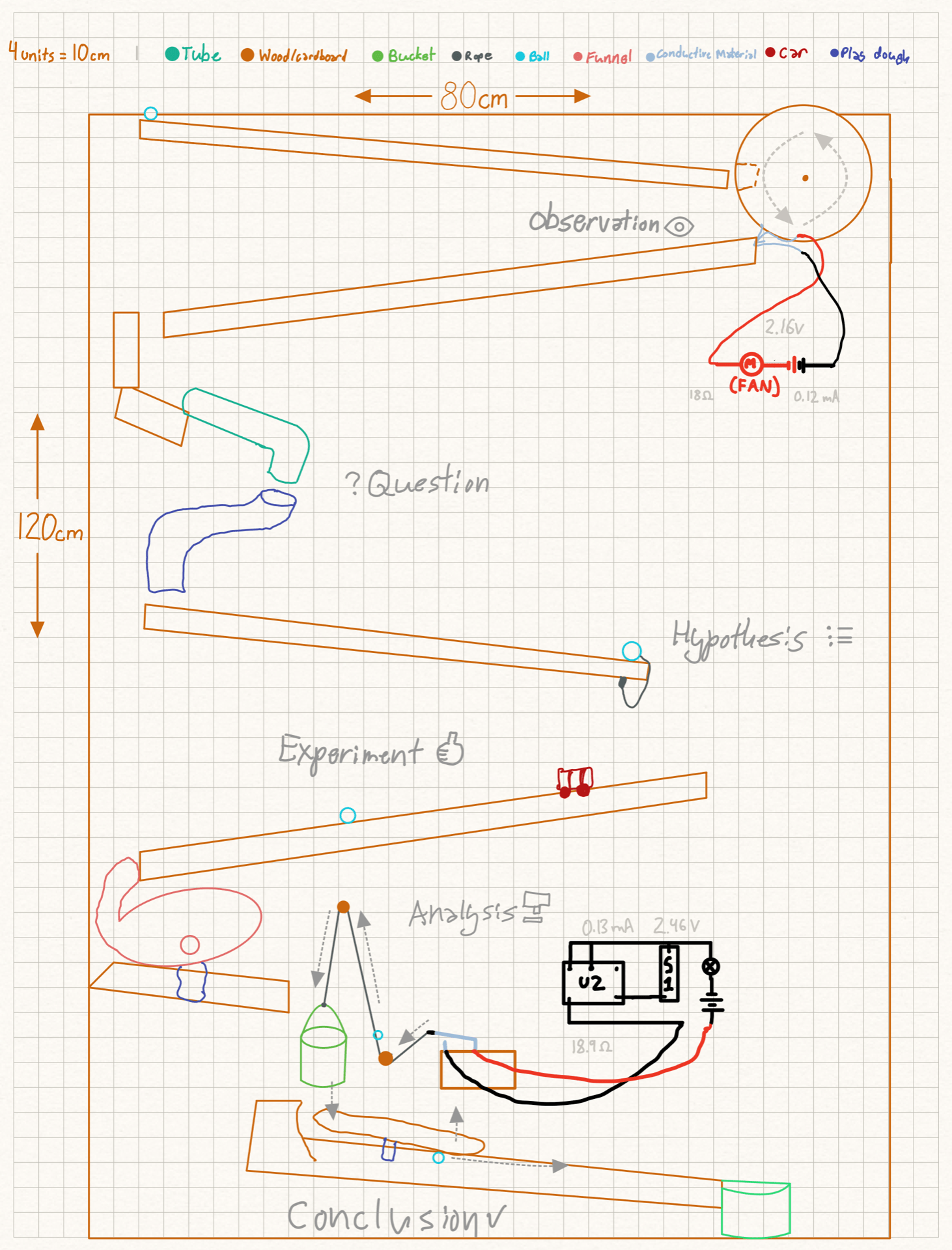New Assignment! Create a Rube Goldberg Machine that is a metaphor for the scientific process. That sounds pretty confusing (I was definitely confused), but don’t worry it’s not quite as complicated as it sounds, watch the video below to see our Rube Goldberg Machine in action and learn the 6 steps of the scientific process:
This project had two driving questions:
1. How can we represent the scientific method?
I think our video does an excellent job at answering this driving question, as it shows one way to represent the scientific method in the form of a Rube Goldberg Machine.
2. What factors affect the function and efficiency of electric circuits?
Several factors can affect the function and efficiency of a circuit such as the number of loads, the type of materials and the voltage, current and resistance.
 We got to do several labs to learn more about electricity for Milestone 2. We (my partners for this project: Ava and Hannah) learned how to write a lab report and how to gather the data for the experiment. This was an excellent way to develop my skill on the curricular and “Planning and conducting: Select and use appropriate equipment, including digital technologies, to systematically and accurately collect and record data.” For the experiment we created a simple circuit with a power source, wires and lightbulbs. We then used a voltmeter to find the Voltage and Current. We then used Ohms Law: V (Voltage) = I (Current) R (Resistance), to calculate the Resistance.
We got to do several labs to learn more about electricity for Milestone 2. We (my partners for this project: Ava and Hannah) learned how to write a lab report and how to gather the data for the experiment. This was an excellent way to develop my skill on the curricular and “Planning and conducting: Select and use appropriate equipment, including digital technologies, to systematically and accurately collect and record data.” For the experiment we created a simple circuit with a power source, wires and lightbulbs. We then used a voltmeter to find the Voltage and Current. We then used Ohms Law: V (Voltage) = I (Current) R (Resistance), to calculate the Resistance.
V = IR
V = ?
I = 8
R = 4
I x R = 8 x 4
= 32
V = 32
V = IR
V = 25
I = 6
R = ?
I ÷ R = 25 ÷ 6
= 4.16
R = 4.16 Ω
We experimented with several different numbers of lightbulbs. We also built the same circuits in this PHET Electricity Simulator. We then compared the differences of the Voltage, Current and Resistance between the physical and digital circuits. Here’s my lab reports (click to open):


We used Khan academy to learn about how to create scale diagrams. Milestone 3 was a Khan academy quizzes. I found the scale diagram math a little confusing at first, but with some practice I was able to understand it better.
We then put our newly gained scale diagram knowledge to use for Milestone 4: Blueprints for our Rube Goldberg Machine. We first created an individual blueprint of our idea of what our metaphor machine could look like. Here’s mine:
Then we worked with our team to merge our individual blueprints into a group blueprint:
We then used a large piece of paper to create a full sized blueprint, thankfully our scale diagrams worked and we were able to fit our full Rube Goldberg Machine on the piece of life sized paper as planned! Making the blueprints helped me work on my ability for the curricular competency “Reasoning and Analyzing: Estimate reasonably” by showing accurate measurements and easily distinguished lines on a grid scale.
We then began building our Rube Goldberg Machine using scrap pieces of wood, cardboard, cups, plasticine and more. We used a plywood board to glue the components of our machine onto. Since we used all of our class time efficiently and kept focus on work, we were able to extend on the curricular competency “Questioning and Predicting: Demonstrate a sustained intellectual curiosity about a scientific topic or problem of personal interest”

While building the machine we made some changes that weren’t on our original blueprint, we replaced the curly tube with a spinning wheel and changed the location of the circuits.
Finally we made short video of our Rube Goldberg Metaphor Machine. It took several takes to get a clip of the machine working from top to finish, but, 15 takes later, we managed to get one! Here’s our final scale diagram blueprint that corresponds with our completed Rube Goldberg Machine:
Here’s our final Rube Goldberg Machine:
We then filmed several close up clips of specific parts of the machine. I then used iMovie to edit and add voiceovers to create our final video. This video was a great way for us to show our ability to extend at the curricular competency “Scientific Communication: Formulate physical or mental models to describe a phenomenon.” The video contains explanations of each part of the Rube Goldberg Machine and how it connects to the Scientific Process. If you didn’t watch our video at the top of this post, make sure to do so now!
We explored a lot of topics in this project, from electricity to scale diagrams and math to a fully working Rube Goldberg Machine. I had a lot of fun building and filming our Rube Goldberg Machine. A big thank you to my team members Ava and Hannah for being enthusiastic and fun partners for this project, I look forward to working with you again on future projects!





Wow!!!!!!!!!
Thank You!